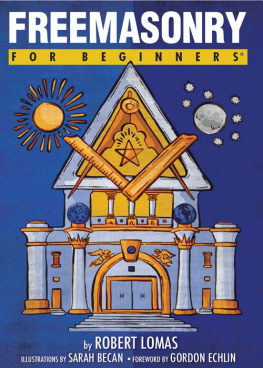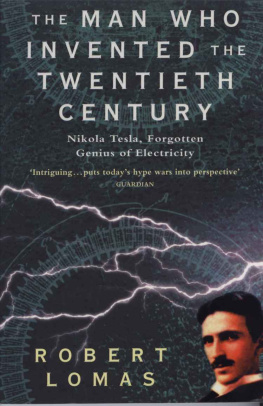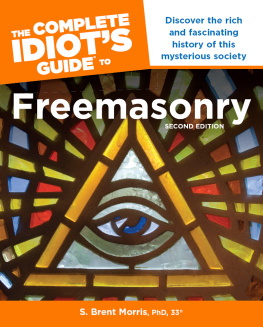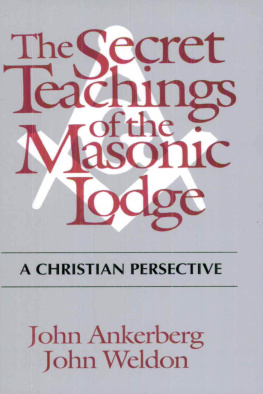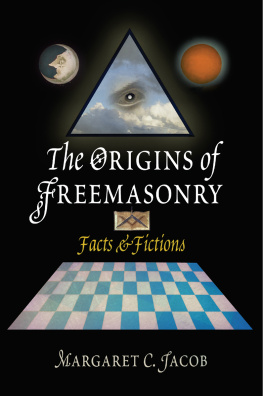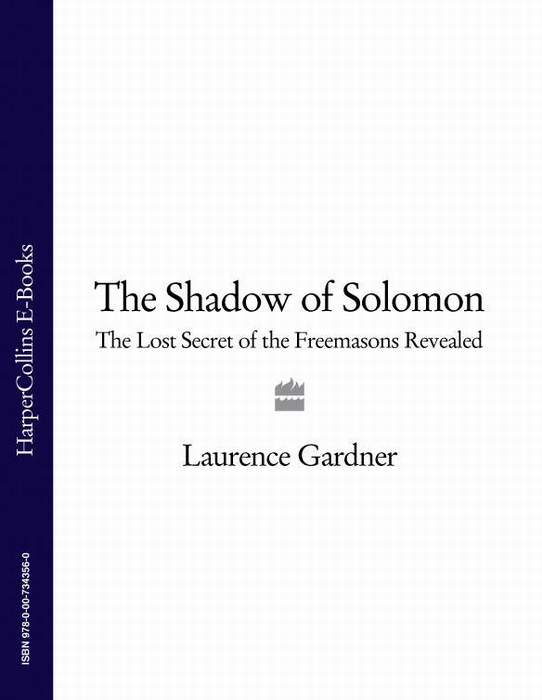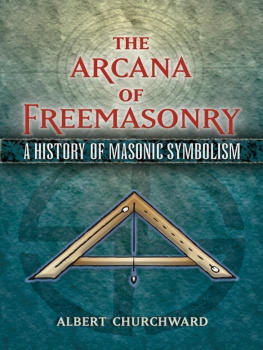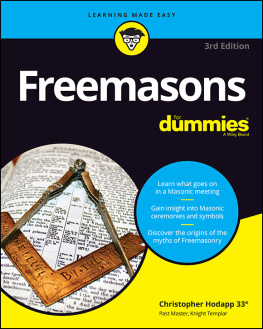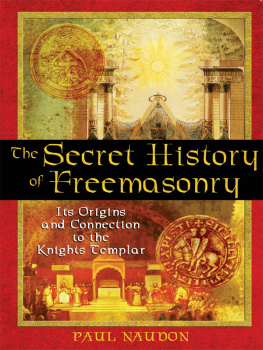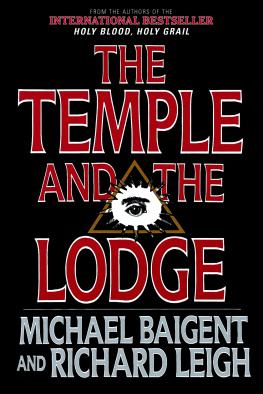R OBERT L OMAS gained a first class honours degree in electronics before being awarded a PhD for his research into solid-state physics. He later worked on electronic weapons systems and emergency services command and control systems. He has established himself as one of the worlds leading authorities on the history of science and lectures on Information Systems at Bradford University School of Management, one of the UKs leading business schools, where he also runs the universitys highly popular website of Masonic source material (www.bradford.ac.uk/webofhiram/).
He is a frequent speaker on the Masonic lecture circuit in West Yorkshire and a regular supporter of the Orkney International Science Festival. He has written a number of bestselling books: Turning the Hiram Key, The Invisible College, Freemasonry and the Birth of Modern Science and The Man Who Invented the Twentieth Century; and co-authored The Hiram Key, The Second Messiah, Uriels Machine and The Book of Hiram.

Constable & Robinson Ltd
3 The Lanchesters
162 Fulham Palace Road
London W6 9ER
www.constablerobinson.com
Copyright Robert Lomas 2006
The right of Robert Lomas to be identified as the author of this work has been asserted by him in accordance with the Copyright, Designs and Patents Act 1988.
All rights reserved. This book is sold subject to the condition that it shall not, by way of trade or otherwise, be lent, re-sold, hired out or otherwise circulated in any form of binding or cover other than that in which it is published and without a similar condition including this condition being imposed on the subsequent purchaser.
A copy of the British Library Cataloguing in Publication Data is available from the British Library
ISBN-10: 1-84529-312-6
ISBN-13: 978-1-84529-312-3
eISBN: 978-1-78033-368-7
Printed and bound in the EU
3 5 7 9 10 8 6 4
Dedication
To Bro. Michael Astell, who proposed me into Freemasonry
Acknowledgments
Firstly, I would like to thank Colin Wilson for introducing me to Duncan Proudfoot at Constable & Robinson. Colin knew I had a large amount of research material on the writers Duncan was interested in so The Secrets of Freemasonry was born. Then I would like to thank Duncan for his editorial support and encouragement; he shaped the concept and encouraged me to have a go at bringing the ideas of Preston, Gould, Ward, Waite and Wilmshurst to a new audience.
I would also like to thank John Wheelwright for his excellent editing skills, cheerful comments and wry sense of humour, my agent Bill Hamilton and his team at AM Heath for sorting out the necessary details, and, finally, John Acaster for reminding me what an important influence the attitude of the United Grand Lodge of England towards free-thinkers has been over the centuries.
Introduction
The Origins of the Craft
Forbidden Views
In 1871 the Daily Telegraph ran a leader about the origins of Freemasonry. This said:
That Freemasonry dates from before the Flood; that it is a mere creation of yesterday; that it is only an excuse for conviviality; that it is a soul-destroying, atheistic organization; that it is a charitable association, doing good under a silly pretence of secrecy; that it is a political engine of extraordinary potency; that it has no secrets; that its disciples possess in secret the grandest knowledge vouchsafed to humanity; that they celebrate their mysterious rites under the auspices and the invocations of Mephistopheles; that their proceedings are perfectly innocent, not to say supremely stupid; that they commit all the murders which are not traced to somebody else; and that they exist only for the purpose of promoting universal brotherhood and benevolence these are some of the allegations made by babblers outside the circle of the Free and Accepted brethren.
In 1995 I happily used this quotation to open my own first venture into understanding the origins of Freemasonry, a book called The Hiram Key. It went on to say:
A great number of well-informed men have set out before us to try and find the origins of Freemasonry, and none of the obvious possibilities have been overlooked by them, or indeed by the ranks of the romancers and charlatans who have joined in the hunt. For some the line is simple: Freemasonry is as old as its publicly recorded history (the seventeenth century) and everything claimed to predate those records is whimsical nonsense. This ultra-pragmatic attitude is clean and uncomplicated, but it is the easiest of all hypotheses to reject for many reasons, not least the fact that there is widespread evidence to show that the Order materialized slowly over more than three hundred years before the establishment of the United Grand Lodge of England.
The fact is, the organization that we now call Freemasonry was a secret society before the mid-seventeenth century, and secret societies, by definition, do not publish official histories. From the establishment of the United Grand Lodge of England in 1717 onwards the Order has been open about its existence, and only its methods of recognition have been kept from public gaze. We will not spend time on proving that Freemasonry was not a spontaneous arrival because it is a theory that has already been widely discredited.
When I first began studying the origins of Freemasonry I found it difficult to uncover real information; there were lots of opinions but few contemporary books to study. Most of the modern booklets from the United Grand Lodge of England took the view that Freemasonry started in London in 1717. Apparently it sprang, fully formed, into the minds of a small group of London gentlemen, who were inspired by the ideas of working builders to create a whole system of ritual and mythology that then spread throughout the world. The Masonic idea caught on quickly and took a firm hold on the imagination of a large part of humanity. Differences of race and language did not prevent its spread.
The books I consulted in my early days of studying Freemasonry all took the success of the Masonic idea for granted. They did not seem at all disturbed by the thought that the nobility of Europe had been sucked into acting out little plays that involved its members taking on the role of jobbing builders. I was fascinated. So I set out to try and discover the secret of the widespread appeal of Freemasonry, which had lasted for over three hundred years.
The ritual of Freemasonry claims that the Craft is at least three thousand years old. I soon found that not only did the opponents of the Order dismiss this possibility but the United Grand Lodge of England (UGLE) didnt accept it either. Indeed UGLE went out of its way to discourage any idea that there could be a history of Freemasonry that predated its own formation in 1717.
During the late 1980s and early 1990s the permanent officials of United Grand Lodge of England were totally hostile to any attempts to investigate their origins. They allowed their so-called lodges of research to debate unendingly the limited historical evidence of who drank which toasts to whom at which lodge meeting, but anyone questioning the official viewpoint, as I did, was quickly told that they would not get any promotion within the system. Usually this was very effective at stopping ambitious insiders asking the wrong questions. But, although I was by then a Masonic insider, I had no Masonic ambitions and was highly sceptical of the explanations peddled in the research newsletters of lodges such as the highly opinionated Quatuor Coronati. I soon found that this lodge, which calls itself the premier lodge of authentic Masonic research, has a long track record of supporting the UGLE party line on the London origins of Freemasonry which I already knew to be an untenable position.
Next page

